A wildflower experiment
In my garden, I sowed a native California wildflower meadow. It was a very fun project and I learned a lot. Now, in another area of my garden I call “The Natural Meadow” I continue more experiments! See what I did!
First of all, my objective here was to add very few plants to this large area, untouched and unplanted. I wanted to keep it as natural as possible. In this meadow are non-native grasses, Yerba santa, Eriodictyon californicum, Goldenfleece, Ericameria arborescens and a small live oak on the downward slope. I also knew that there were lots of native bulbs, lupine and Valley tassels that appear in the spring. Everything else was weeds.
1. First thing I attempted was to weed the entire area, How to weed a meadow in the Sierra Foothills
2. Then I planted three deer grass and three Cleveland sage.
3. Now I wanted to add some different wildflower seedlings, grown from a native wildflower mix.
I sowed the seeds in these seed trays using a wintersown method, where you leave them to the weather and only water if very dry. Our winter was average and snow-covered these from time to time. The plan was to transplant them into my natural meadow. Isolating the seedlings in the trays would allow me to learn, also, what the seedlings looked like and to photograph them for future.
They were sown last January first, from the same CA native wildflower seed mix from S&S Seeds purchased last Fall and sown for the meadow project. By mid April, they were well-grown and healthy!
The seedlings are ready to be planted. The area I chose to transplant them was about ten feet from the trunk of the oak. morning shade, afternoon sun.
The seed blocks were a bit dry after a week of no rain and the seed tray was deep enough that a fork worked well to lift or pry each block out.
The area to be planted is in a field, the ‘The Natural Meadow’ and located straight off the back of the house, two levels down beyond the Patio Garden and the Salvia Garden.
This meadow has only been weeded, removing filaree whenever it’s seen and planted with three Deer Grasses, Muhlenbergia rigens. This weeding project, which took a solid week, encouraged thousands of Pretty Face (or Golden Stars), Triteleias ixioides and Elegant Brodiaea, Brodiaea elegans sprouts which every year bloom in May. These sprouts can be seen in these photos as slender straps about 6 inches tall.

Each block was planted with a small basin uphill and a watering ring on the downhill side to catch water
The planting area for the seedlings is in morning shade of a small oak, a remnant of one that was removed for our 70 foot long septic leach lines, which are on the uphill and downhill sides of the meadow.
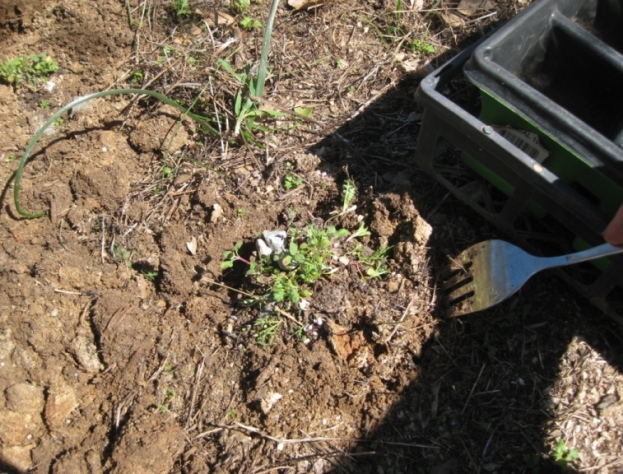
Once the block was placed, the soil surrounding it was flaked and pushed down around it. Dirt from the hole was used for the watering ring
The seeds were sown in native soil mixed half and half with potting soil. Each planting hole is dug, as close in size as the block, so as not to disturb too much soil. Then, the soil is pushed from around the sides, the dirt from the hole filling in and being used for the tin watering ring. A small indentation is dug on the uphill side to catch water.
Each block contained Lupine, Poppy, Baby Blue Eyes and Five Spot, I noticed. The whole list of what was sown is here.
Each block was placed about 10 inches apart and hopefully next year will reseed. As the blocks are planted, I notice masses of tiny feverfew seedlings which I scrape off the surface of the soil with the edge of the trowel. I don’t mind feverfew some places, but not here.
Each seed block or ‘muffin’ is soaked with water. I feel happy about planting right before the rain.
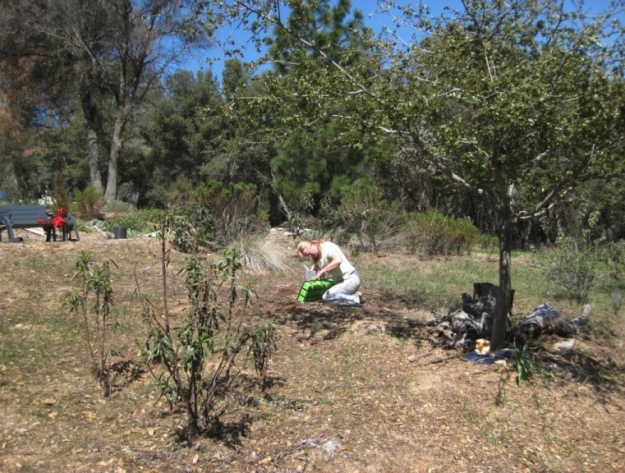
Scraggley Yerba Santa in the foreground. The last seedling block is planted. The thick green area behind me is the Sierra National Forest boundary.
The last muffin is dug out from the tray. These Yerba Buena in the field are cut down by half in Fall and so will grow bushier. They have pretty lavender flowers in May, but can look ratty the rest of the year unless trimmed.
I checked, they’re fine, amazingly, being young native Californians, but many of the other wintersown seedlings sown the same day were damaged during the last frost. Like always, we’ll see, and you along with me!



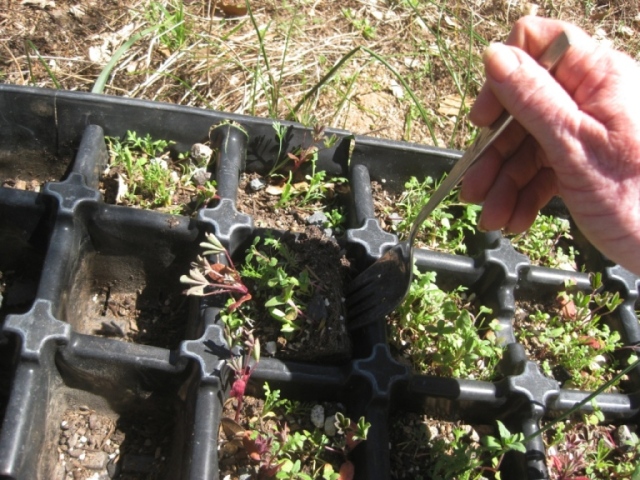
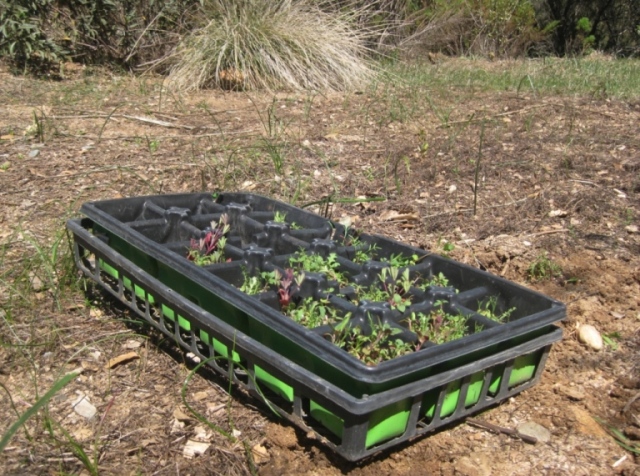


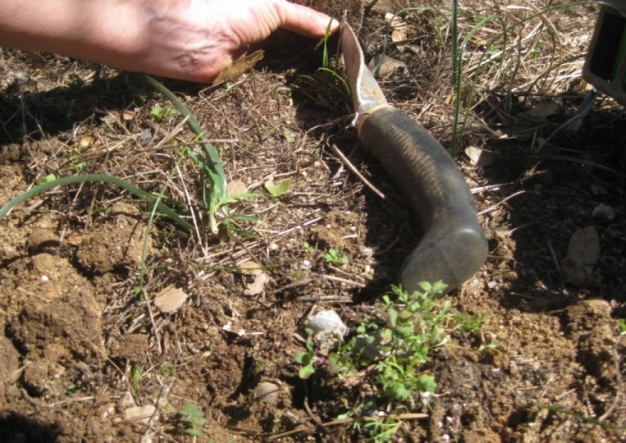
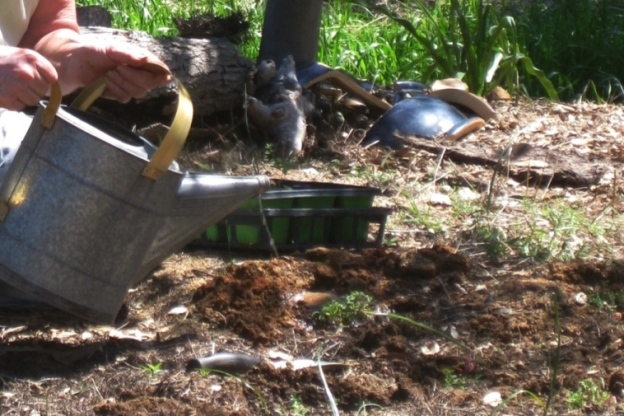
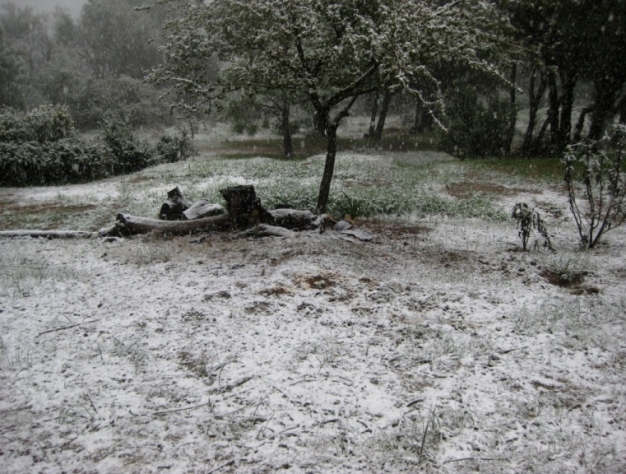

4 comments